sometimes these can be worked out pretty easily in table. would someone do this in at table. i have seen a bunch of solutions but still dont get it. maybe a table based solution can do the trick.. thanks
Lima Beans and Brussels Sprouts:
Of the students who eat in a certain cafeteria, each student either likes or dislikes lima beans and each student either likes or dislikes brussels sprouts. Of these students, 2/3 dislike lima beans; and of those who dislike lima beans, 3/5 also dislike brussels sprouts. How many of the students like brussels sprouts but dislike lima beans.
(1) 120 students eat in the cafeteria
(2) 40 of the students like lima beans.
gmatprep - Lima Beans and Brussels Sprouts:
This topic has expert replies
-
hengirl03
- Senior | Next Rank: 100 Posts
- Posts: 86
- Joined: Tue Aug 05, 2008 10:50 am
- Thanked: 7 times
A table isn't need for this question. If you can figure out how many students like lima beans, then you can figure out the rest.
From statement #:
(1) You are given that 120 students eat in the cafeteria. From this you can determine the number of dislike lima beans (80 students). Therefore, 80 x(2/5) students dislike lima beans, but like brussel sprouts.
(2) The problem gives you that 2/3 of the students don't like lima beans. This statement gives you the number of students that LIKE lima beans. So, these 40 students account for 1/3 of the student population. Once, you have the number of students who like lima beans, the problem is solved in the same way that statement (1) is.
The answer is D.
Hope this helps
From statement #:
(1) You are given that 120 students eat in the cafeteria. From this you can determine the number of dislike lima beans (80 students). Therefore, 80 x(2/5) students dislike lima beans, but like brussel sprouts.
(2) The problem gives you that 2/3 of the students don't like lima beans. This statement gives you the number of students that LIKE lima beans. So, these 40 students account for 1/3 of the student population. Once, you have the number of students who like lima beans, the problem is solved in the same way that statement (1) is.
The answer is D.
Hope this helps
- vineetbatra
- Master | Next Rank: 500 Posts
- Posts: 355
- Joined: Thu Feb 19, 2009 12:42 pm
- Thanked: 2 times
- Followed by:1 members
Well I have slight confusion. It says Of those students, 2/3 dislike lima beans; and of those who dislike lima beans, 3/5 also dislike brussels sprouts. If my answer is D then I am assuming that students who do not like BS are only 3/5 th of the ones that do not like LB.hengirl03 wrote:A table isn't need for this question. If you can figure out how many students like lima beans, then you can figure out the rest.
From statement #:
(1) You are given that 120 students eat in the cafeteria. From this you can determine the number of dislike lima beans (80 students). Therefore, 80 x(2/5) students dislike lima beans, but like brussel sprouts.
(2) The problem gives you that 2/3 of the students don't like lima beans. This statement gives you the number of students that LIKE lima beans. So, these 40 students account for 1/3 of the student population. Once, you have the number of students who like lima beans, the problem is solved in the same way that statement (1) is.
The answer is D.
Hope this helps
In other words, if you dislike BS then you dislike LB. This seems flawed becuase there could be students who dislike BS but still like LB, because no where it says that disliking BS is only a subset of disling LB.
Just interpretation. I hope i am able to explain my point here.
-
hengirl03
- Senior | Next Rank: 100 Posts
- Posts: 86
- Joined: Tue Aug 05, 2008 10:50 am
- Thanked: 7 times
Lima Beans and Brussels Sprouts:
Of the students who eat in a certain cafeteria, each student either likes or dislikes lima beans and each student either likes or dislikes brussels sprouts. Of these students, 2/3 dislike lima beans; and of those who dislike lima beans, 3/5 also dislike brussels sprouts. How many of the students like brussels sprouts but dislike lima beans.
(1) 120 students eat in the cafeteria
(2) 40 of the students like lima beans.
The part that is in bold is a key part to answering the question. This phrase tells you that of the people that don't like LB, 3/5 also don't like BS.
It might be easier to understand my point, if you draw out a 2x2 table. On the top put lima beans, one square for like and one for dislike. On the right but brussel sprouts, one square for like and one for dislike.
The question is asking you to determine how many of the students like brussels sprouts but not lima beans. The question gives you the amount of students that like dislike lima beans, so you can disregard the like lima bean" half of the table.
The question also gives you 3/5 of those you DON'T like lima beans, ALSO don't like brussel sprouts.
So, in order to fill out the two remaining parts of the table, you need figure out how many people don't like lima beans. You can obtain this amount using the information posted in (1) or using the information posted in (2); hence the answer is D.
Hope this helps
Of the students who eat in a certain cafeteria, each student either likes or dislikes lima beans and each student either likes or dislikes brussels sprouts. Of these students, 2/3 dislike lima beans; and of those who dislike lima beans, 3/5 also dislike brussels sprouts. How many of the students like brussels sprouts but dislike lima beans.
(1) 120 students eat in the cafeteria
(2) 40 of the students like lima beans.
The part that is in bold is a key part to answering the question. This phrase tells you that of the people that don't like LB, 3/5 also don't like BS.
It might be easier to understand my point, if you draw out a 2x2 table. On the top put lima beans, one square for like and one for dislike. On the right but brussel sprouts, one square for like and one for dislike.
The question is asking you to determine how many of the students like brussels sprouts but not lima beans. The question gives you the amount of students that like dislike lima beans, so you can disregard the like lima bean" half of the table.
The question also gives you 3/5 of those you DON'T like lima beans, ALSO don't like brussel sprouts.
So, in order to fill out the two remaining parts of the table, you need figure out how many people don't like lima beans. You can obtain this amount using the information posted in (1) or using the information posted in (2); hence the answer is D.
Hope this helps
- Attachments
-
- Here is the diagram of the table that I mentioned in my post.
- vineetbatra
- Master | Next Rank: 500 Posts
- Posts: 355
- Joined: Thu Feb 19, 2009 12:42 pm
- Thanked: 2 times
- Followed by:1 members
Thanks for the reply, well my question is not the calculation, but the logic. i.e. it says that thos wo do not like LB also do not like BS.
If i assume that those who do not like BS are ONLY 3/5 of students disliking LB, then I agree with your calculation.
My q is, how do I infer that the ones that do not like BS are only 3/5th of LB, there could be others that like LB, but still dislike BS.
I hope I making a head or tail out my question.
If i assume that those who do not like BS are ONLY 3/5 of students disliking LB, then I agree with your calculation.
My q is, how do I infer that the ones that do not like BS are only 3/5th of LB, there could be others that like LB, but still dislike BS.
I hope I making a head or tail out my question.
-
hengirl03
- Senior | Next Rank: 100 Posts
- Posts: 86
- Joined: Tue Aug 05, 2008 10:50 am
- Thanked: 7 times
You don't make that inference. In order to determine the total amount of those that don't like brussel sprouts, you'll need to use the information that is in this problem IN ADDITION to information that tell you what fraction of those who like lima beans also don't like brussel sprouts.
Instead just focus on what the problem gives you.
The problem states:
- 2/3 of the total doesn't like lima beans
- Of this 2/3 that don't like lima beans, 3/5 also doesn't like Brussel Sprouts.
Once you use the information in (1) or (2), you can find the number of people who don't like lima beans, but do like brussel sprouts (because this group is 2/5 of the 2/3 that doesn't like lima beans).
Instead just focus on what the problem gives you.
The problem states:
- 2/3 of the total doesn't like lima beans
- Of this 2/3 that don't like lima beans, 3/5 also doesn't like Brussel Sprouts.
Once you use the information in (1) or (2), you can find the number of people who don't like lima beans, but do like brussel sprouts (because this group is 2/5 of the 2/3 that doesn't like lima beans).
Vineet:
Of these students, 2/3 dislike lima beans; and of those who dislike lima beans, 3/5 also dislike brussels sprouts. How many of the students like brussels sprouts but dislike lima beans.
The scope of this question is limited to those students who dislike Lima Beans. The question does not ask us about those students who LIKE LBs.
If i assume that those who do not like BS are ONLY 3/5 of students disliking LB, then I agree with your calculation.My q is, how do I infer that the ones that do not like BS are only 3/5th of LB, there could be others that like LB, but still dislike BS.
I had this confusion as well. But look at the whole question.In other words, if you dislike BS then you dislike LB. This seems flawed becuase there could be students who dislike BS but still like LB, because no where it says that disliking BS is only a subset of disling LB.
Just interpretation. I hope i am able to explain my point here.
Of these students, 2/3 dislike lima beans; and of those who dislike lima beans, 3/5 also dislike brussels sprouts. How many of the students like brussels sprouts but dislike lima beans.
The scope of this question is limited to those students who dislike Lima Beans. The question does not ask us about those students who LIKE LBs.
-
Testluv
- GMAT Instructor
- Posts: 1302
- Joined: Mon Oct 19, 2009 2:13 pm
- Location: Toronto
- Thanked: 539 times
- Followed by:164 members
- GMAT Score:800
A reasoning approach is far quicker here than a matrix approach. (And all you need for a good reasoning approach here is some facility with fractions and translation).
Determine what sets you have info for, and then focus on what sets you are being asked about. Next, determine what info would be minimally necessary in order to answer the question.
Here:
The question is asking for how many dislike lima beans but like brussel sprouts.
Let's now look at the info in the question stem. There's quite a bit of info in the question stem. In these questions, that's a good signal that you can arrive at an important deduction before going to the statements...perhaps even a deduction that will allow you to predict the statements.
We are told that 2/3 of the total number of students dislike lima beans; and, we are told that, of these, 3/5 dislike brussel sprouts. Well, because each student in any set can only like or dislike brussel sprouts, if 3/5 of them dislike brussel sprouts, then 2/5 of them like brussel sprouts.
Therefore, the number of students who dislike lima beans but like brussel sprouts is (2/3)*(2/5) of X, where X is the total number of students.
Therefore, to have sufficiency, all we need to know is the total number of students or information that would allow us to compute the total number of students.
Now we are ready to turn to the statements.
(1) 120 students eat in the cafeteria
Sufficient. ( (2/3) * (2/5) * 120 would give us the answer)
(2) 40 of the students like lima beans.
We know from the stem that 1/3 of the total number of students like lima beans. Therefore, with this info we would easily be able to compute the total number of students (1/3 *total = 40, and you can solve for total)
Sufficient.
Determine what sets you have info for, and then focus on what sets you are being asked about. Next, determine what info would be minimally necessary in order to answer the question.
Here:
The question is asking for how many dislike lima beans but like brussel sprouts.
Let's now look at the info in the question stem. There's quite a bit of info in the question stem. In these questions, that's a good signal that you can arrive at an important deduction before going to the statements...perhaps even a deduction that will allow you to predict the statements.
We are told that 2/3 of the total number of students dislike lima beans; and, we are told that, of these, 3/5 dislike brussel sprouts. Well, because each student in any set can only like or dislike brussel sprouts, if 3/5 of them dislike brussel sprouts, then 2/5 of them like brussel sprouts.
Therefore, the number of students who dislike lima beans but like brussel sprouts is (2/3)*(2/5) of X, where X is the total number of students.
Therefore, to have sufficiency, all we need to know is the total number of students or information that would allow us to compute the total number of students.
Now we are ready to turn to the statements.
(1) 120 students eat in the cafeteria
Sufficient. ( (2/3) * (2/5) * 120 would give us the answer)
(2) 40 of the students like lima beans.
We know from the stem that 1/3 of the total number of students like lima beans. Therefore, with this info we would easily be able to compute the total number of students (1/3 *total = 40, and you can solve for total)
Sufficient.
Kaplan Teacher in Toronto
GMAT/MBA Expert
- Brent@GMATPrepNow
- GMAT Instructor
- Posts: 16207
- Joined: Mon Dec 08, 2008 6:26 pm
- Location: Vancouver, BC
- Thanked: 5254 times
- Followed by:1268 members
- GMAT Score:770
Here's your Matrix, Neo ...juanpadh wrote:still do not get, can anyone upoad the matrix?
We can use the Double Matrix Method to solve this question. This technique can be used for most questions featuring a population in which each member has two characteristics associated with it.Of the students who eat in a certain cafeteria, each student either likes or dislikes lima beans and each student either like or dislikes Brussels sprouts. Of theses students, 2/3 dislike lima beans; and of those who dislike lima beans, 3/5 also dislike Brussels sprouts. How many of the students like Brussels sprouts but dislike lima beans?
(1) 120 students eat in the cafeteria
(2) 40 of the students like lima beans.
Here, we have a population of students, and the two characteristics are:
- like Brussels sprouts or dislike Brussels sprouts
- like lima beans or dislike lima beans
So, we can set up our diagram as follows:
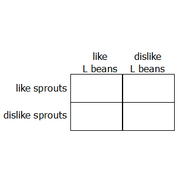
Target question: How many of the students like Brussels sprouts but dislike lima beans?
Let's place a STAR in the box representing those students who like Brussels sprouts but dislike lima beans.
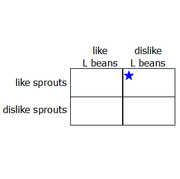
Since we don't know the TOTAL NUMBER of students, let's let x represent the total student population. So, we'll add that to our diagram as well.
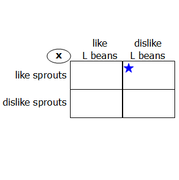
Given: 2/3 dislike lima beans
So, (2/3)x = total number of students who dislike lima beans
This means the other 1/3 LIKE lima beans. In other words, (1/3)x = total number of students who LIKE lima beans.
We'll add that to the diagram:
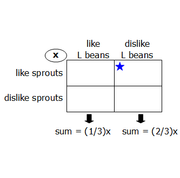
Given: Of those who dislike lima beans, 3/5 also dislike Brussels sprouts
If (2/3)x = total number of students who dislike lima beans, then (3/5)(2/3)x = total number of students who dislike lima beans AND dislike Brussels sprouts.
(3/5)(2/3)x simplifies to (2/5)x, so we'll add that to our diagram:
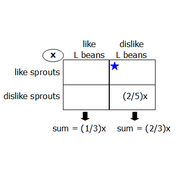
Finally, since the two boxes in the right-hand column must add to (2/3)x, we know that the top-right box must = (4/15)x [since (2/3)x - (2/5)x = (4/15)x]
So, we can add that to the diagram:
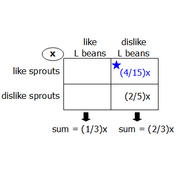
Great! We're now ready to examine the statements.
Statement 1: 120 students eat in the cafeteria
In other words, x = 120
Plug x = 120 into the top-right box to get: (4/15)(120) = 32
So, there are 32 students who like Brussels sprouts but dislike lima beans.
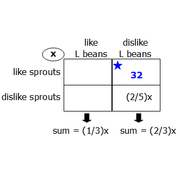
Since we can answer the target question with certainty, statement 1 is SUFFICIENT
Statement 2: 40 of the students like lima beans.
The left-hand column represents students who like lima beans.
In total, (1/3)x = total number of students who LIKE lima beans.
So, statement 2 is telling us that (1/3)x = 40
We can solve the equation to conclude that x = 120
Once we know the value of x, we can determine the number of students who like Brussels sprouts but dislike lima beans (we already did so in statement 1)
Since we can answer the target question with certainty, statement 2 is SUFFICIENT
Answer = D
------------------------------
To learn more about the Double Matrix Method, watch our free video: https://www.gmatprepnow.com/module/gmat- ... ems?id=919
Once you're familiar with this technique, you can attempt these additional practice questions:
Easy Problem Solving questions
- https://www.beatthegmat.com/the-aam-aadm ... 72242.html
- https://www.beatthegmat.com/finance-majo ... 67425.html
Medium Problem Solving questions
- https://www.beatthegmat.com/probability- ... 73360.html
- https://www.beatthegmat.com/posted-speed ... 72374.html
- https://www.beatthegmat.com/motel-t271938.html
- https://www.beatthegmat.com/of-the-appli ... 70255.html
- https://www.beatthegmat.com/opening-nigh ... 64869.html
- https://www.beatthegmat.com/ds-french-ja ... 22297.html
Difficult Problem Solving questions
- https://www.beatthegmat.com/ratio-problem-t268339.html
- https://www.beatthegmat.com/overlapping- ... 65223.html
- https://www.beatthegmat.com/fractions-t264254.html
- https://www.beatthegmat.com/overlapping- ... 64092.html
- https://www.beatthegmat.com/mba/2011/05/ ... question-2
Easy Data Sufficiency questions
- https://www.beatthegmat.com/for-what-per ... 70596.html
- https://www.beatthegmat.com/ds-quest-t187706.html
Medium Data Sufficiency questions
- https://www.beatthegmat.com/sets-matrix-ds-t271914.html
- https://www.beatthegmat.com/each-of-peop ... 71375.html
- https://www.beatthegmat.com/a-manufacturer-t270331.html
- https://www.beatthegmat.com/in-costume-f ... 69355.html
- https://www.beatthegmat.com/mba/2011/05/ ... question-1
Difficult Data Sufficiency questions
- https://www.beatthegmat.com/double-set-m ... 71423.html
- https://www.beatthegmat.com/sets-t269449.html
- https://www.beatthegmat.com/mba/2011/05/ ... question-3
Cheers,
Brent
- GMATGuruNY
- GMAT Instructor
- Posts: 15539
- Joined: Tue May 25, 2010 12:04 pm
- Location: New York, NY
- Thanked: 13060 times
- Followed by:1906 members
- GMAT Score:790
This is an EITHER/OR group question.Of the students who eat in a certain cafeteria, each student either likes or dislikes lima beans, and each student either likes or dislikes brussel sprouts. Of these students, 2/3 dislike lima beans; and of those who dislike lima beans, 3/5 also dislike brussel sprouts. How many of the students like brussels sprouts but dislike lima beans?
(1) 120 students eat in the cafeteria
(2) 40 students like lima beans.
Every student EITHER dislikes lima beans OR likes lima beans.
Every student EITHER dislikes brussel sprouts OR likes brussels sprouts.
For an EITHER/OR group problem, use a GROUP GRID to organize the data.
Let DL = dislikes limas, LL = likes limas, DB = dislikes brussels sprouts, and LB = likes brussels sprouts.
There are two fractions in the question stem: 2/3 and 3/5.
Since the product of the denominators = 3*5 = 15, let the TOTAL = 15x.
Here's the grid:
Now let's use the information in the question stem to complete as much of the grid as possible._______________DL______LL_______Total
DB:
LB:
Total:___________________________15x
Values in the grid have to add up horizontally and vertically.
As soon as we know 2 entries in a row or a column, we can calculate the remaining entry in that row or column.
2/3 dislike lima beans:
Since (2/3)(15x) = 10x, we get:
Of those who dislike lima beans, 3/5 also dislike brussel sprouts._______________DL______LL_______Total
DB:
LB:
Total:__________10x______5x_______15x
Since (3/5)(10x) = 6x, we get:
The question stem asks for the number of students who like brussels sprouts but dislike lima beans: 4x._______________DL______LL_______Total
DB:____________6x_______________
LB:____________4x_________________
Total:_________10x______5x_______15x
To determine the value of 4x, we need to know the value of x.
Question rephrased: What is the value of x?
Statement 1: 120 students eat in the cafeteria
Since the total number of students = 15x, we get:
15x = 120
x = 8.
SUFFICIENT.
Statement 2: 40 students like lima beans.
Since the total number of students who like lima beans = 5x, we get:
5x = 40
x = 8.
SUFFICIENT.
The correct answer is D.
Private tutor exclusively for the GMAT and GRE, with over 20 years of experience.
Followed here and elsewhere by over 1900 test-takers.
I have worked with students based in the US, Australia, Taiwan, China, Tajikistan, Kuwait, Saudi Arabia -- a long list of countries.
My students have been admitted to HBS, CBS, Tuck, Yale, Stern, Fuqua -- a long list of top programs.
As a tutor, I don't simply teach you how I would approach problems.
I unlock the best way for YOU to solve problems.
For more information, please email me (Mitch Hunt) at [email protected].
Student Review #1
Student Review #2
Student Review #3
Followed here and elsewhere by over 1900 test-takers.
I have worked with students based in the US, Australia, Taiwan, China, Tajikistan, Kuwait, Saudi Arabia -- a long list of countries.
My students have been admitted to HBS, CBS, Tuck, Yale, Stern, Fuqua -- a long list of top programs.
As a tutor, I don't simply teach you how I would approach problems.
I unlock the best way for YOU to solve problems.
For more information, please email me (Mitch Hunt) at [email protected].
Student Review #1
Student Review #2
Student Review #3




















